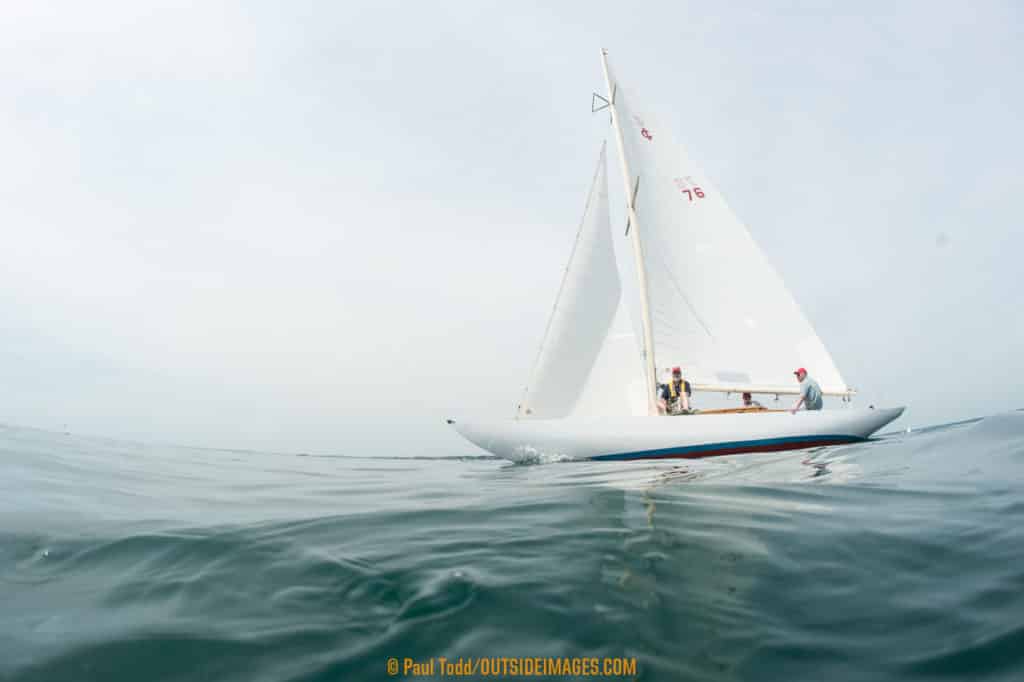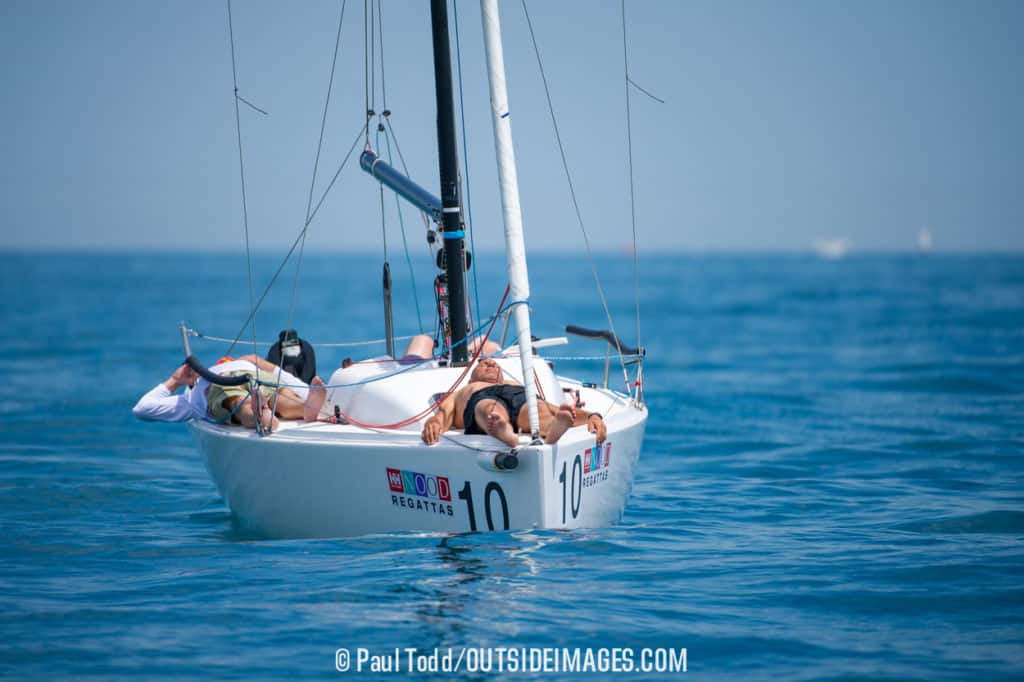
Dinghies and scows, catamarans and cruisers, Optimists and canting-keel maxis. Of all the different boats we race, one thing holds true: racing them downwind in light air can really suck. It’s always tedious, it’s usually hot, and the going is slow. Rodney always seems to be crossing your bow in his powerboat with the hammer down. Who is with me? I thought so.
But, it’s summertime in North America, and those light, long downwind legs are unavoidable. In this frustration that everyone shares lies the opportunity to gain distance and pass boats. So let’s look at some basic light-air downwind concepts that will help the next time you are facing a race day in the light stuff. We will focus on strategy and boatspeed in this story. Tactics and boathandling will come next month.
Sail in the pressure
It doesn’t matter what kind of boat you race, your absolute No. 1 priority should be to sail in the maximum windspeed on the course. When the wind is light, it’s even more important. Here’s why. If you are sailing on a 12-knot day, a puff of 1.5 knots more wind represents 12 percent more breeze. But when you’re slapping along in 6 knots of wind, that same increase of 1.5 knots equals a 25-percent bump in the windspeed. In light air, there’s a lot of potential boatspeed in these puffs, so go after the pressure.
Also, because you are sailing away from the wind on a downwind leg, you spend a lot more time traveling in a single puff or band of pressure than you would upwind. When we race America’s Cup boats in less than 12 knots, we always hoist a good sailor up the rig to look around. The view of the puffs on the water from 100 feet up is quite clear and the perspective is well worth carrying the weight aloft, even upwind. Going up the rig may not be an option on your boat, but standing up is. So, on a regular basis, get as much elevation as you realistically can and look around for the best pressure.
The best time to sniff out the puffs is before you start the run. One of my favorite advances in sailboat racing is the offset leg. This 20-second reach gives me time to look around, think about what worked on the last beat, and decide where I want to be for the run. If I already have a plan in mind for the run, the offset leg allows me time to confirm or change the plan, if necessary. Did one side pay on the upwind leg due to more pressure? If so, I set myself up for that same side on the downwind leg.
In a regatta like Acura Key West Race Week, where there are multiple classes racing on the same course, I like to monitor what’s happening in the other classes. What side seems to be paying for them?
Once you spot the pressure, the trick is making sure you sail through it. This can be harder than it sounds; the puff is usually in motion and, obviously, so are you. On a light-air run, most boats will be sailing with an apparent wind angle between 75 and 90 degrees. This means the next line of pressure may actually be in front of you, not behind as it is in heavier air. Look at where your masthead wind indicator is pointing. This is a great guide to where you look for the next lines of pressure. On a Farr 40 in light air, I usually stand to leeward and just in front of the helmsman. From there, I look forward through the windward shrouds to see future pressure opportunities.
As the breeze builds toward double digits, and you are sailing a wider apparent wind angle, your sightline for the pressure will move aft. But it is important to remember where your apparent wind is coming from, and make sure there is a good supply of the strongest puffs on their way.
Sail the long jibe
Before you round the windward mark, determine which tack was the long one upwind. The opposite downwind jibe will be the long one downwind, and it will be favored because it will point you closer to the leeward mark. If, for example, you spent most of your time on starboard tack upwind, then you will likely be spending most of your time on port jibe on the next leg-so consider a jibe to port soon after rounding the mark. Of course, this is dependent on traffic and clear air, but we’ll cover that next month.
You can also watch the other classes on your course. Did the leaders of their respective fleets come from the left or the right? Typically, if there is a strong bias on the run, the puffs will also be coming from that side.
If you’re unsure, the default call should always be to sail for the pressure. As the breeze increases, the priority may swing more toward the angle than the pressure. On a very light run, pressure is king.
Be careful of the middle
The traditional strategy for a windward/leeward racecourse says the sides of the course are risky and the middle is the safe place to be. From the middle of the course you can plot a conservative strategy, and minimize loss as the wind shifts, both upwind and downwind.
In light air, because we are a lot more concerned with pressure over direction, it’s the other way around. In light air, new lines of pressure will usually come from one edge of the track, and quite often the middle gets the puffs last.
I am not advocating booking a table for one at the Corner Café every time you go downwind in 6 to 8 knots. But when it’s really light, if you can work the edge with more pressure, without losing touch with the majority of the fleet, you will set yourself up for a good run. From the edges of the track, you should get the pressure first, and if you are on the long jibe, you can keep your maneuvers to a minimum.

Keep it fast
Similar to the windspeed example, the differences in boatspeed can be exponential downwind in light air. One-tenth of a knot can represent a significant percentage increase when you’re only doing 3 or 4 knots over the ground, and turn into a big gain over the course of a leg. Being vigilant about sailing in maximum pressure will make you fast, but these tips may help as well:
When in doubt, heat it up. In light air with a symmetric spinnaker, you probably already have the pole forward to the headstay. This is the optimum light-air setting when sailing hotter angles (i.e. with a smaller true wind angle). If you are not sure what angle to sail downwind, compare your angle to that of other boats in your class. But when in doubt, err on keeping the boat fast, rather than trying to sail too low.
A common mistake in light air is to carry the pole tip too high. When in doubt, keep the pole tip low. Generally speaking, a low pole should help the boat accelerate in the puffs, and stabilize the spinnaker in any seaway.
Communicate. The trimmer should constantly talk to the driver about how much pressure he or she is carrying in the spinnaker. I try to avoid phrases like “up five” or “down five” because they may cause the helmsman to oversteer. Instead, I prefer that the trimmer set limits. For example, “The pressure is good, no higher than this,” or “Don’t sail lower than 140 (degrees true wind angle).” On a larger boat that has wind instruments, agreeing on a true wind angle range can be a good way to keep the boat sailing at optimum angle. Keep in mind that this TWA range will change in puffs and lulls, and with different spinnakers you use, but it can be a good starting point for communication.
Also, remember that in light air, wind instruments can be at their worst, due to wind shear and calibration anomalies. So be careful with the information on the displays.
Another interesting way to sail downwind in light air, if you have a decent instrument system, is to sail by heel angle. Think of angle of heel as another representation of how much power you are carrying in the sailplan, similar to the tug on the spinnaker sheet.
Most modern raceboats like to carry a bit of heel downwind to reduce wetted surface on the hull and to use gravity to help fill the kite. Every class of boat will be different, but when you are feeling like you are in a good mode downwind, note the angle of heel, and create a target range to sail (for example, between 4 to 7 degrees). This can be another way to check your own feel of the boat, and to duplicate settings if you don’t have the same trimmers and driver throughout the season.
Keep the turns gradual and smooth to preserve your speed. When you accelerate in the big puff, don’t scrub off all your speed in one sharp turn, do it slowly over 10 to 15 seconds. You want to avoid big spikes and drops in your speed.
We all know that when racing on a summer weekend, you will probably encounter heinous powerboat chop at some point during the day. When Rodney is making a pass, keep the crew weight as low as possible to reduce pitching.
Most keelboats will benefit by dropping a few crewmembers down below, also known as putting dogs in the house. This can be miserable for the designated crew, though an ample cookie supply and some interesting reading material can make it more enjoyable.
Keep the topping lift and foreguy snug in the waves, but keep a hand on the foreguy, in case the spinnaker guy requires adjustment.
Trim both sails. In sounds obvious, but I am amazed how often I see a perfectly trimmed spinnaker, and a luffing or overtrimed mainsail. Getting the main to set correctly in light air may mean easing the main halyard down a click to deepen the middle of the sail, adjusting the vang tension for the puffs, and constantly testing the sheet ease. A set of telltales near the luff of the main can help keep the trimmer honest.









